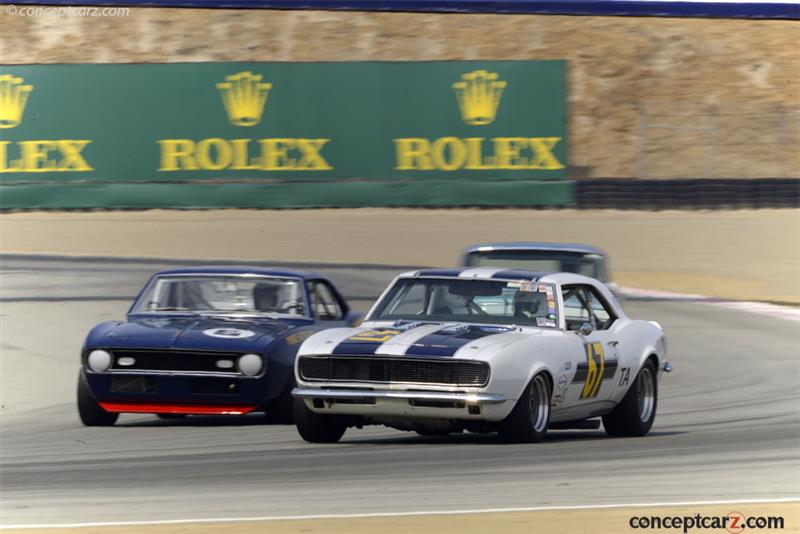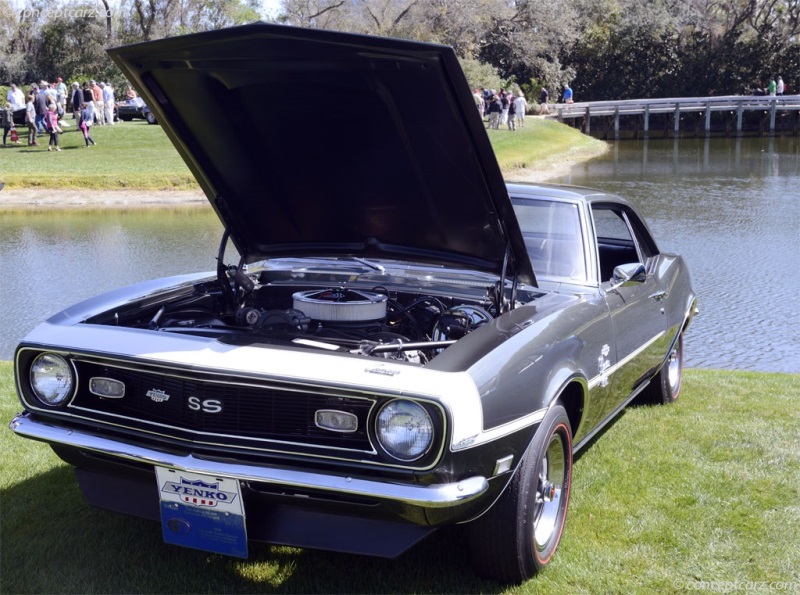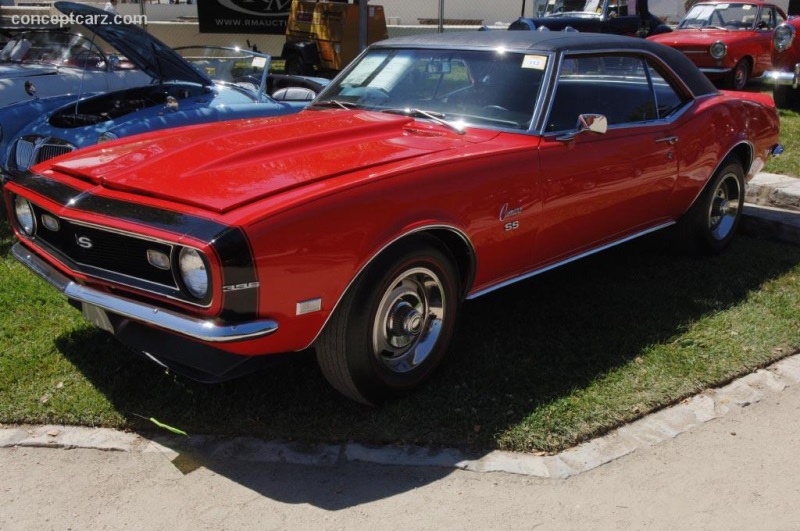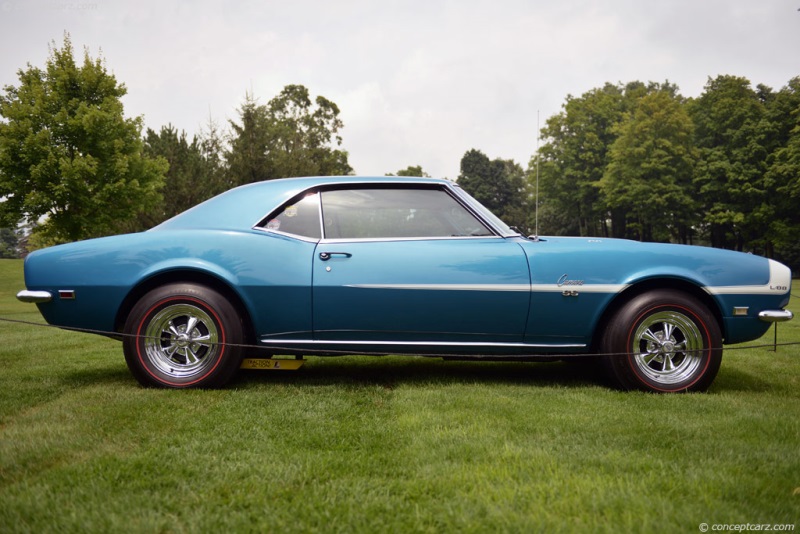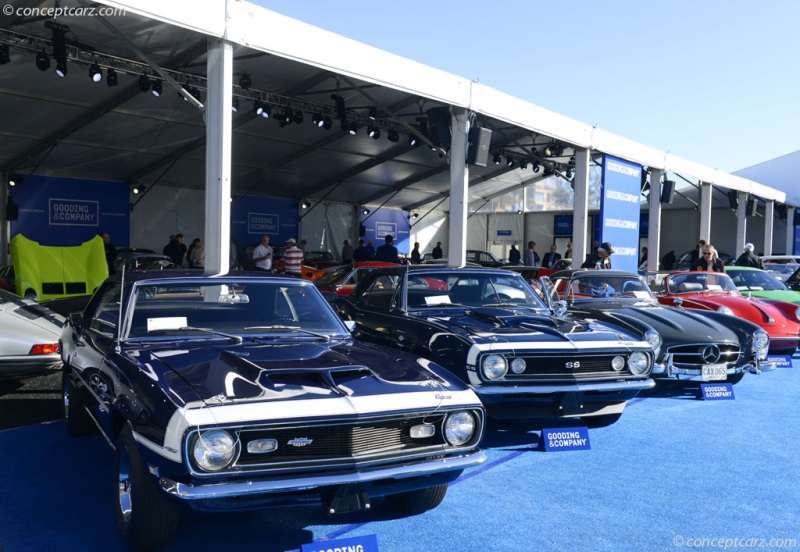The 1960s brought about a new generation of powerful, big-block V8 saloon cars in the United States that became known as 'Muscle Cars.' Ford was first to market with its dramatic new Mustang, while other 'Motor City' favorites included the Pontiac GTO, Dodge Charger, Plymouth Barracuda and the Chevrolet Camaro. When the Camaro was introduced in 1966, it was offered in 2-door form with both coupe and convertible body styles, along with a range of various engine sizes, and styling and trim packages. The top option was the Z28 powered by a 302 cubic-inch, 5-liter small-block V8, which was also used to homologate the car for Group 2 racing in the Sports Car Club of America Trans-America Series. Rules allowed cars with up to 5.7-liter engines to compete. The list of famous Camaro drivers included Mark Donohue, ex-F1 pilot Ronny Bucknum and Jerry Thompson. Donohue captured the 1968 and 1969 season's championships driving a Penske-prepared Camaro. The base engine in the Camaro was the Turbo-Thrift overhead-valve, 230 cubic-inch inline six-cylinder engine with 140 horsepower. The base V-8 engine was an overhead-valve 327 CID unit with 210 horsepower and 320 lbs-ft of torque. It had hydraulic valve lifters, five main bearings, cast-iron block and head, and a 9.00:1 compression ratio. A variety of transmission options were offered, including a fully synchronized three-speed manual with a column-mounted gearshift. Other options included a four-speed manual, Powerglide automatic (M20 wide-ratio, M21 close-ratio, and M22 close-ratio heavy-duty), and Hydra-Matic. In the front was an independent suspension with coil springs, with Mono-Leaf rear leaf springs and bias-mounted rear shock absorbers - the V8-engined cars had multi-leaf rear springs. There were Safety-Master self-adjusting brakes, a dual-chamber brake master cylinder, Rayon-reinforced brake hoses, and a foot-operated-parking brake. A 12-volt electrical system used a 9-37 amp Delcotron diode-rectified generator. Steering was handed by a re-circulating ball setup with a 28.3:1 manual gear ratio. The base six-cylinder coupe had a price of $2,560 while the convertible sold for $2,800. 176,813 of the base coupes were sold and 20,440 of the convertibles. 40,977 had the Rally Sport option, 30,695 selected the SS option, and 7,199 were fitted with the Z/28 option package. New features for 1968 included front and rear side marker lights, and one-piece curved side windows. The convertible had a manual convertible top, bright windshield moldings, convertible top latches, dual courtesy lights, and unique inside rear quarter panels with built-in arm-rests. Both the coupe and convertible had all-vinyl front bucket seats, an all-vinyl rear bench seat, new interior door styling with bright metal inserts, a three-spoke wheel with circular 'Camaro' horn button, an energy-absorbing steering column, and a new gauge cluster with large round speedometer and fuel gauges, Astro Ventilation with cowl side vents and two adjustable vent-ports located on the instrument panel. The individuals in the front had shoulder belts with push-button buckles, and the rear passengers had seat belts with push-button buckles. There was a padded instrument panel, padded sun visors, and padded windshield pillars. A 'reduced-glare' feature was added to the instrument panel top, horn button, inside windshield moldings, and steering wheel hub. 
Series 24 V8 Coupe
Chassis #: 005-7602The Rally Sport trim option cost Chevrolet dealers $81.35 and was sold to customers for $105.35. Basically an appearance package, it added concealed headlights, a unique full-width grille, and small rectangular directional signal and parking lights located below the bumper instead of in the grille. There were RS emblems on the center of the grille and on the round gas filler cap in the center of the rear body panel, and 'Rally Sport' script on the upper front fenders behind the wheel openings. There were small rectangular back-up located below the rear bumper, bright lower bodyside moldings with black lower bod finish under the molding, a bright roof drip molding on Sport coupes and a bright beltline molding. The RPO Z27 SS (Super Sport) package (including the SS 350 and SS 396) varied depending on the engine but came with a host of performance modifications, improved suspension, strengthened chassis, SS emblem for the center of the grille and fuel-filler cap, special hood insulation, red stripe or white stripe, wide-oval tires, front accent band, and dual exhaust system. The SS 396 package came with a unique hood with twin banks of four square simulated air intakes.607 examples of the Z/28 were sold in 1967, and management was still wrestling if they should market it as an option strictly for racing or to the public. For 1968, sales grew to 7,199 examples, reinforcing the decision to sell it to the eager public. The Z/28 was available only on the sport coupes and came in four different variations. Power was from the 302-CID small-block, with standard equipment that included a dual exhaust system, special suspension, heavy-duty radiator, deep-tone mufflers, a temperature-controlled de-clutching radiator fan, quick-ratio steering, a 3.73:1 rear axle ratio, stripes on the hood and on the rear deck lid, and larger wheels and tires. The Z/28 could be fitted with power front disc brakes of heavy-duty front disc brakes with metallic rear linings. Chevrolet recommended that buyers of the Z/28 add the Posi-Traction rear axle. Penske Camaro
Six Camaros were delivered to Penske's Philadelphia garage near the close of 1967 in preparation for the 1968 season. They were painted in the trademark Sunoco blue livery and the list of drivers included Mark Donohue, Craig Fisher, Joe welch, Sam Posey, and Bob Johnson. 1968 marked the addition of the 12 Hours of Sebring and the 24 Hours of Daytona, the only year that the Trans-Am Series featured those races. Additionally, this was the first season that an event was held outside the United States, when teams competed at the Mont-Tremblant track in Quebec, Canada. Mark Donohue would win the Over 2-liter Manufacturers Championship for Chevrolet with an unprecedented 8 race winning streak, and Chevrolet would win 10 out of the 13 races. Don Yenko
The muscle car game was brought to new heights in 1967 when Don Yenko, along with Dick Harrell, Bill Thomas, Nickey Chevrolet, and others created the Yenko 427 Super Camaro. Don Yenko side-stepped GM's factory displacement limitation by installing a large-bore 427 CID L72 crate motor into approximately 54 examples of the big-block Camaro. With strong sales, Yenko ordered several more cars for 1968 prompting GM to take notice and began reconsidering the concept of the big-block Camaro.
Series 24 V8 Coupe
Chassis #: 005-7602With over 50 L72 conversions, Yenko's small shop in Canonsburg, Pennsylvania had become quite skilled, especially with the L78. The 396 CID L78 engine had a similar port arrangement to the L72 which offered a compatibility that the 350 CID engine did not. Yenko mechanics were able to retain the Holley carburetor and headers of the L78 engines and re-mounted them onto the L72's short block, and then revised the exhausts. Changes to the 1968 Camaro's suspension made it easier for Yenko mechanics to re-tune than the 1967 cars. The Yenko cars also received performance instrument packages and special wheels to accommodate larger tires, as well as a new fiberglass vented hood. For 1968, approximately 64 examples of the Yenko Camaro were produced. The unique Yenko identification number starting with YS-8001 in 1968. Approximately 11 were created with the combined deluxe RS/SS option combination that year.For 1969, Chevrolet and Yenko collaborated on the project, with Chevy equipping COPO (Central Office Production Order) Camaros with the 427 CID motor at the factory, thereby reducing the dealer's tuning role. Thus, the 1968 Camaro's were the last of the small-batch, hand-modified Yenko Camaros.
by Daniel Vaughan | Feb 2020
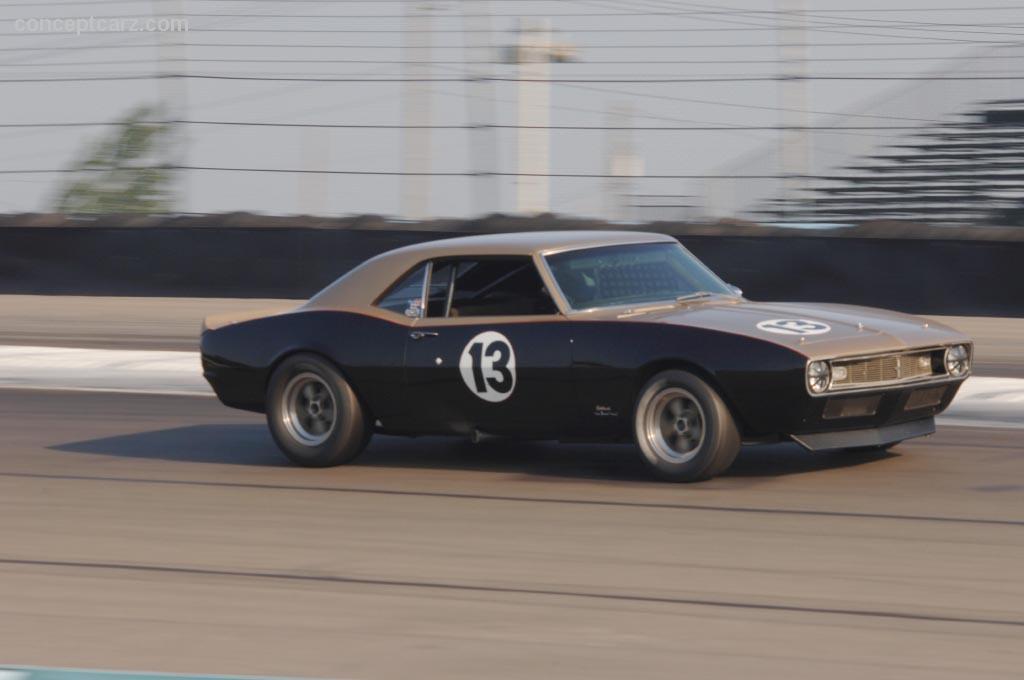
Series 24 V8 Coupe
Chassis #: 005-7602
Six Camaros were delivered to Penske's Philadelphia garage near the close of 1967 in preparation for the 1968 season. They were painted in the trademark Sunoco blue livery and the list of drivers included Mark Donohue, Craig Fisher, Joe welch, Sam Posey, and Bob Johnson. 1968 marked the addition of the 12 Hours of Sebring and the 24 Hours of Daytona, the only year that the Trans-Am Series featured those races. Additionally, this was the first season that an event was held outside the United States, when teams competed at the Mont-Tremblant track in Quebec, Canada. Mark Donohue would win the Over 2-liter Manufacturers Championship for Chevrolet with an unprecedented 8 race winning streak, and Chevrolet would win 10 out of the 13 races. Don Yenko
The muscle car game was brought to new heights in 1967 when Don Yenko, along with Dick Harrell, Bill Thomas, Nickey Chevrolet, and others created the Yenko 427 Super Camaro. Don Yenko side-stepped GM's factory displacement limitation by installing a large-bore 427 CID L72 crate motor into approximately 54 examples of the big-block Camaro. With strong sales, Yenko ordered several more cars for 1968 prompting GM to take notice and began reconsidering the concept of the big-block Camaro.
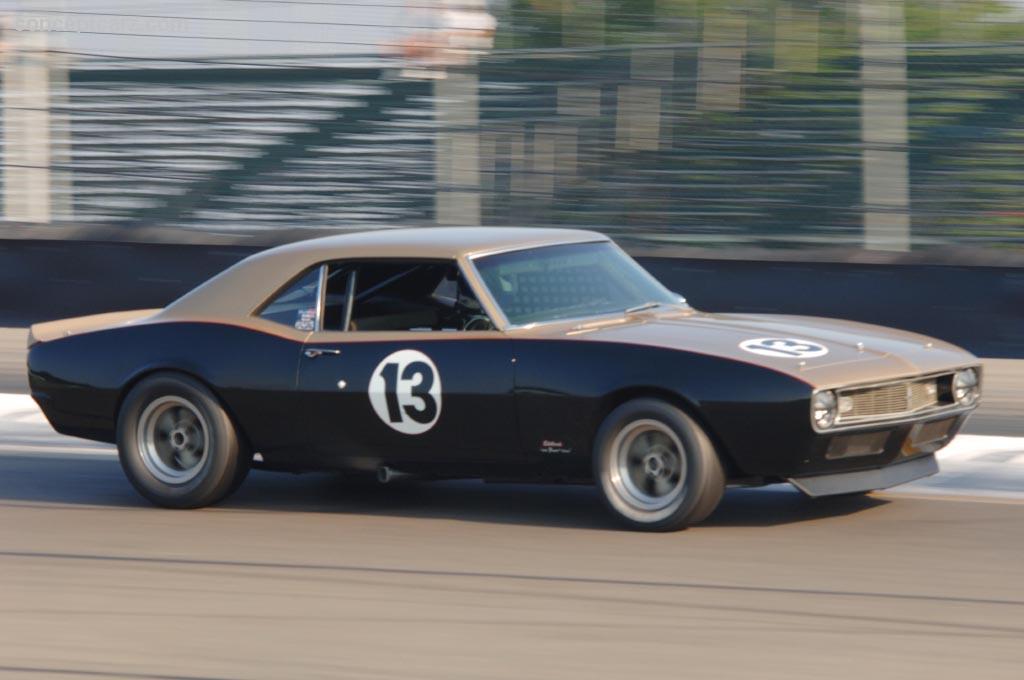
Series 24 V8 Coupe
Chassis #: 005-7602
by Daniel Vaughan | Feb 2020
Related Reading : Chevrolet Camaro History
The Chevrolet Camaro was introduced in 1967 as a compact car specifically built to provide competition for the highly popular Ford Mustang. This pony car was built atop of the same F-Body platform as the Pontiac Firebird, which had a similar production lifespan of 1967 through 2002. During the preproduction stages of the Chevrolet Camaro, General Motors codenamed the vehicle Panther. The name....
Continue Reading >>
Continue Reading >>
Chevrolet
Similar Vehicles
Similarly Sized Vehicles
from 1968
Similarly Priced Vehicles
Chevrolet Monthly Sales Volume
March 2023
398,141
1968 Chevrolet Camaro Vehicle Profiles
Recent Vehicle Additions
Performance and Specification Comparison
Price Comparison
$2,200 - $2,400
$2,250 - $2,624
$2,340 - $3,100
$2,445 - $2,920
$2,500 - $2,630
$2,630 - $3,240
$2,660 - $3,355
$3,220 - $3,570
$4,350 - $4,661
Camaro Generation 1 Specification Comparison by Year
Year
Production
Wheelbase
Engine
Prices
220,906
108.10 in.
8 cyl., 263.00 CID., 195.00hp
8 cyl., 327.00 CID., 210.00hp
8 cyl., 302.00 CID., 290.00hp
8 cyl., 350.00 CID., 295.00hp
8 cyl., 396.00 CID., 350.00hp
8 cyl., 396.00 CID., 375.00hp
8 cyl., 327.00 CID., 210.00hp
8 cyl., 302.00 CID., 290.00hp
8 cyl., 350.00 CID., 295.00hp
8 cyl., 396.00 CID., 350.00hp
8 cyl., 396.00 CID., 375.00hp
$2,500 - $3,310
235,147
106.00 in.
6 cyl., 230.00 CID., 140.00hp
6 cyl., 250.00 CID., 155.00hp
8 cyl., 327.00 CID., 210.00hp
8 cyl., 327.00 CID., 250.00hp
8 cyl., 327.00 CID., 275.00hp
8 cyl., 302.00 CID., 290.00hp
8 cyl., 350.00 CID., 295.00hp
8 cyl., 396.00 CID., 325.00hp
8 cyl., 327.00 CID., 350.00hp
8 cyl., 395.31 CID., 375.00hp
6 cyl., 250.00 CID., 155.00hp
8 cyl., 327.00 CID., 210.00hp
8 cyl., 327.00 CID., 250.00hp
8 cyl., 327.00 CID., 275.00hp
8 cyl., 302.00 CID., 290.00hp
8 cyl., 350.00 CID., 295.00hp
8 cyl., 396.00 CID., 325.00hp
8 cyl., 327.00 CID., 350.00hp
8 cyl., 395.31 CID., 375.00hp
$2,600 - $3,797
243,085
108.00 in.
6 cyl., 230.00 CID., 140.00hp
6 cyl., 250.00 CID., 155.00hp
8 cyl., 307.00 CID., 200.00hp
8 cyl., 327.00 CID., 210.00hp
8 cyl., 350.00 CID., 255.00hp
8 cyl., 302.00 CID., 290.00hp
8 cyl., 350.00 CID., 300.00hp
8 cyl., 396.00 CID., 325.00hp
8 cyl., 396.00 CID., 350.00hp
8 cyl., 396.00 CID., 375.00hp
8 cyl., 427.00 CID., 430.00hp
6 cyl., 250.00 CID., 155.00hp
8 cyl., 307.00 CID., 200.00hp
8 cyl., 327.00 CID., 210.00hp
8 cyl., 350.00 CID., 255.00hp
8 cyl., 302.00 CID., 290.00hp
8 cyl., 350.00 CID., 300.00hp
8 cyl., 396.00 CID., 325.00hp
8 cyl., 396.00 CID., 350.00hp
8 cyl., 396.00 CID., 375.00hp
8 cyl., 427.00 CID., 430.00hp
$2,635 - $2,850
Related Automotive News

Radnor Hunt Concours 2017
The Philadelphia Vintage Grand Prix was failing. The parks department and city put up enough bureaucratic roadblocks to make survival difficult. An event organizer and Radnor Hunt member Mike Tillson redirected his energies. He recalls approaching...
Roger Penske to be Honored with IMRRC's 2016 Argetsinger Award for Contributions to Racing
WATKINS GLEN, N.Y. (April 6, 2016) – Roger Penske, one of auto racings most notable team owners, will be honored in June by the International Motor Racing Research Center (IMRRC) with the 2016 Cameron R. Argetsinger Award for Outstanding Contributions...
RRDC VOTES IN 37 NEW MEMBERS FOR 2013
HILLIARD, Ohio (Nov. 7, 2013) - Thirty-seven race-car drivers and motorsports professionals have been voted into the Road Racing Drivers Club in 2013. The group includes 13 Regular Members from the open-wheel and sports-car racing ranks, 20 Associate...

Celebrating 60 Years of Corvette History at Rolex Monterey Motorsports Reunion
Rarely Seen Corvettes Assemble for Exhibition August 16-19 in Monterey
Monterey, Calif., July 9, 2013 — There are Corvettes, and then there are The Corvettes. Recognizing the power, performance and durability that has made Corvette Ame...

Concours Dealer Super Car Class At The Concours d'Elegance of America
WHAT IS A DEALER SUPER CAR
In the muscle car world, the term Dealer Super Car has specific and very important meaning. There are basically two distinct types, one considerably more valuable and desirable.
Original Dealer Built Super...





























